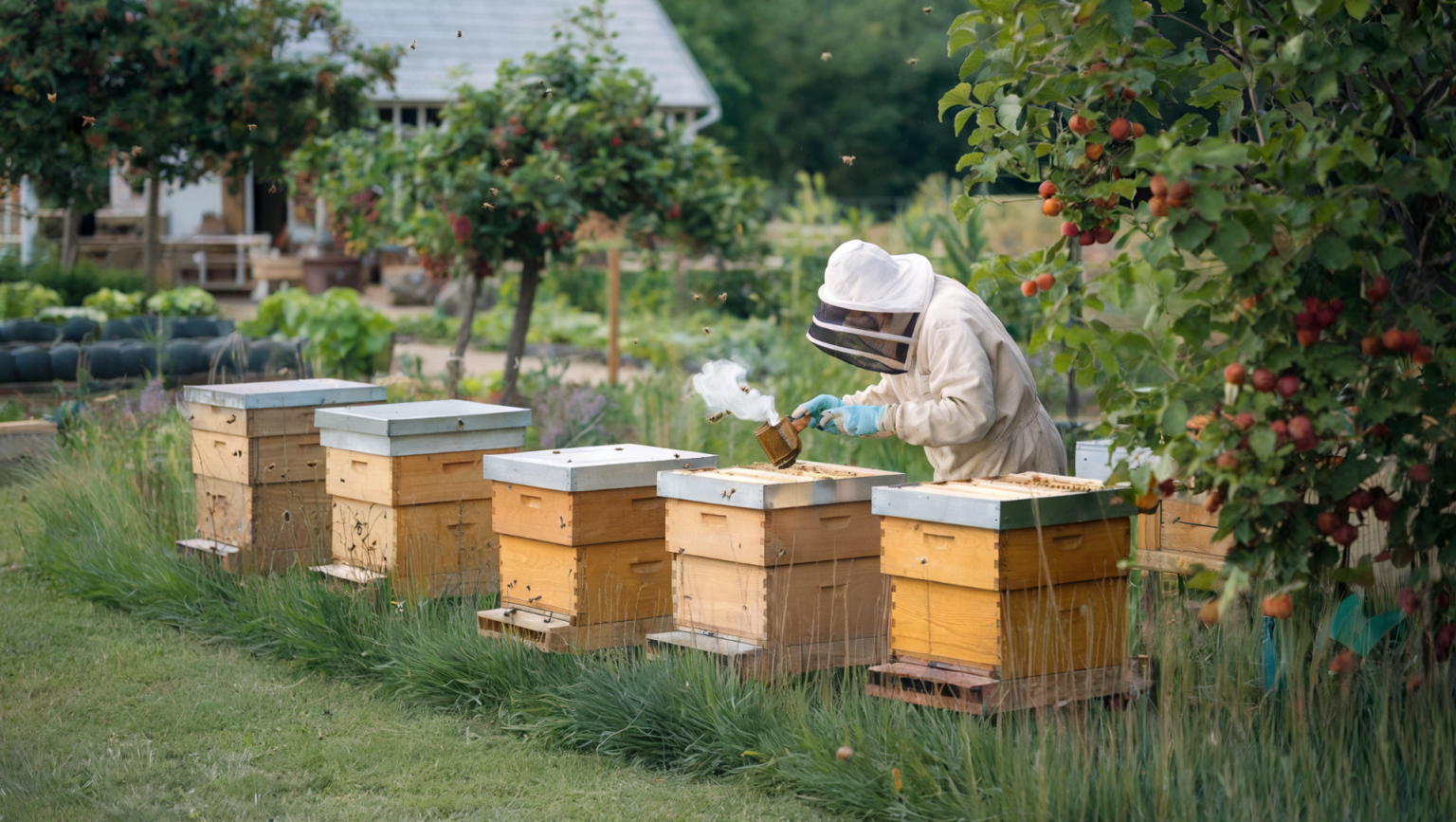Why Beekeeping is a Game-Changer for Your Homestead
In the quest for self-sufficiency and creating a harmonious homestead, beekeeping is a practice that shines. As more people turn toward living off the land, nurturing their food sources, and minimizing waste, bees have become pivotal.
These industrious little pollinators don’t just produce golden, delicious honey—they help sustain a thriving homestead ecosystem!
By fostering a healthy bee colony, you’re encouraging robust plant growth, boosting biodiversity, and, ultimately, ensuring that your crops, flowers, and fruit trees flourish.
Bees are nature’s tireless workers, and by learning beekeeping for beginners, you’re laying the foundation for a fully self-reliant lifestyle and increased food safety for your entire community.
Beekeeping for Beginners: What Is The Best Hive?
Starting your beekeeping journey begins with the hive—your bees’ home. Choosing the right hive is essential for your success as a beekeeper. The most popular options for beginners are the Langstroth, Top Bar, and Warre hives.
Our number one choice for first-time beekeepers is the Langstroth hive for the following reasons:
- Widely Used and Accessible: Langstroth hives are the most common type of beehive, making it easy to find equipment, guides, and local support.
- Modular Design: The hive consists of stackable boxes (called supers) that you can add or remove based on the size of your colony. This makes it easy to expand as your bees grow.
- Ease of Inspection: The removable frames inside the boxes make it simple to inspect your bees and harvest honey without disturbing the colony too much.
- Honey Production: Langstroth hives are efficient for honey production, making them a good choice if your goal is to collect honey.
- Standardization: Most beekeeping tools, from extractors to frames, are designed to fit Langstroth hives, making it easier for beginners to access the right equipment.
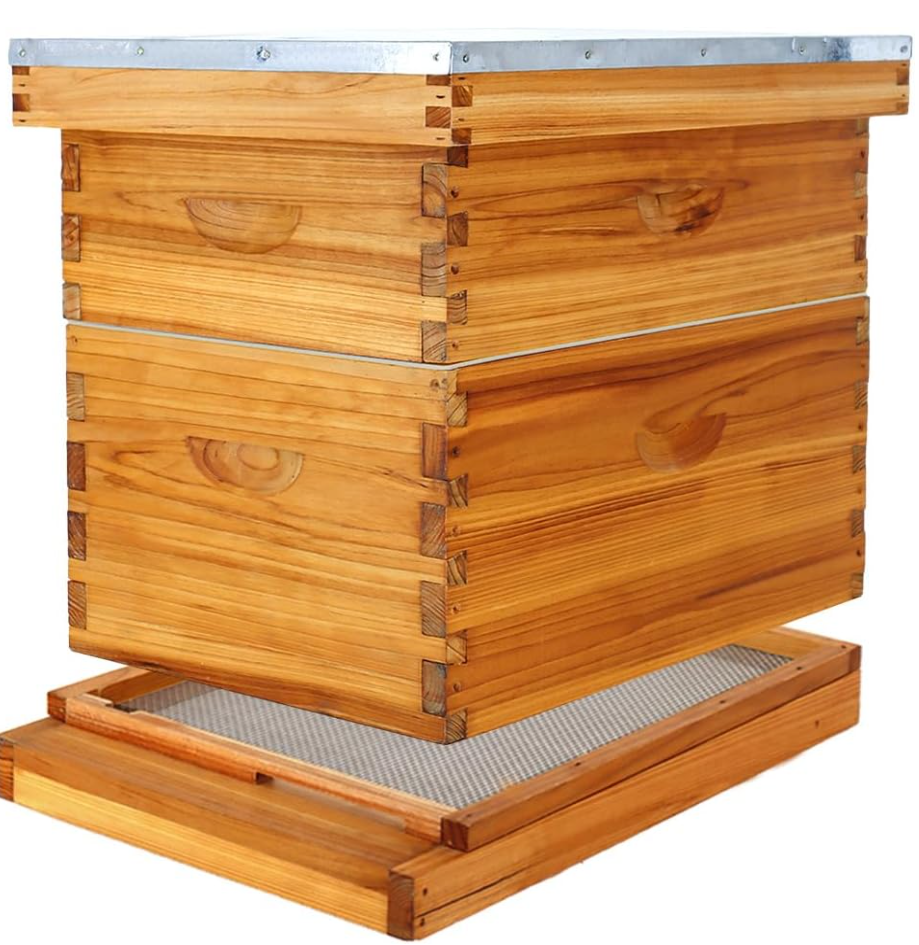
This highly rated Langstroth beehive kit is the perfect way to get started. Plus, it shows off superb craftsmanship and a perfect homestead style. Screened bottom boards provide better ventilation, ensuring the health of your hive.
The Top Bar hive shown below is another solid choice for its simplicity and natural approach to bee management. It has a horizontal design that requires minimal equipment and allows for easy inspections without heavy lifting. Its design encourages natural bee behavior, making it ideal for those focused on small-scale beekeeping.
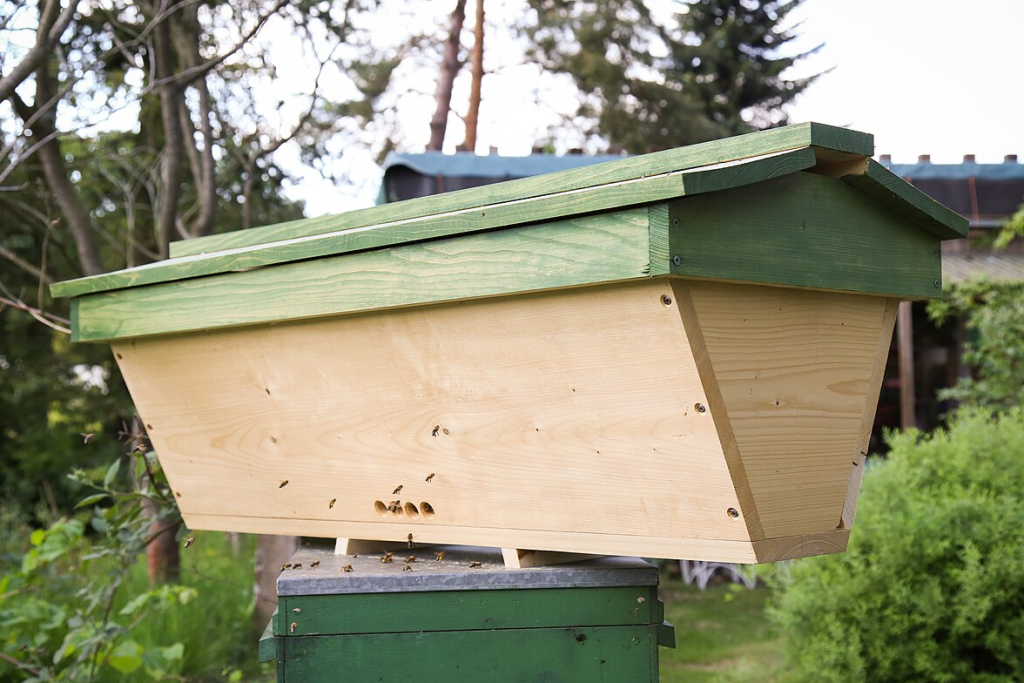
A Warre hive is another good option like the five-box version below courtesy of Shawn Caza on Flickr. It is a vertical hive designed to mimic the bees’ natural environment, promoting minimal intervention from the beekeeper. It’s favored by beekeepers interested in a more hands-off approach, as it allows bees to build natural comb and requires less frequent inspections.
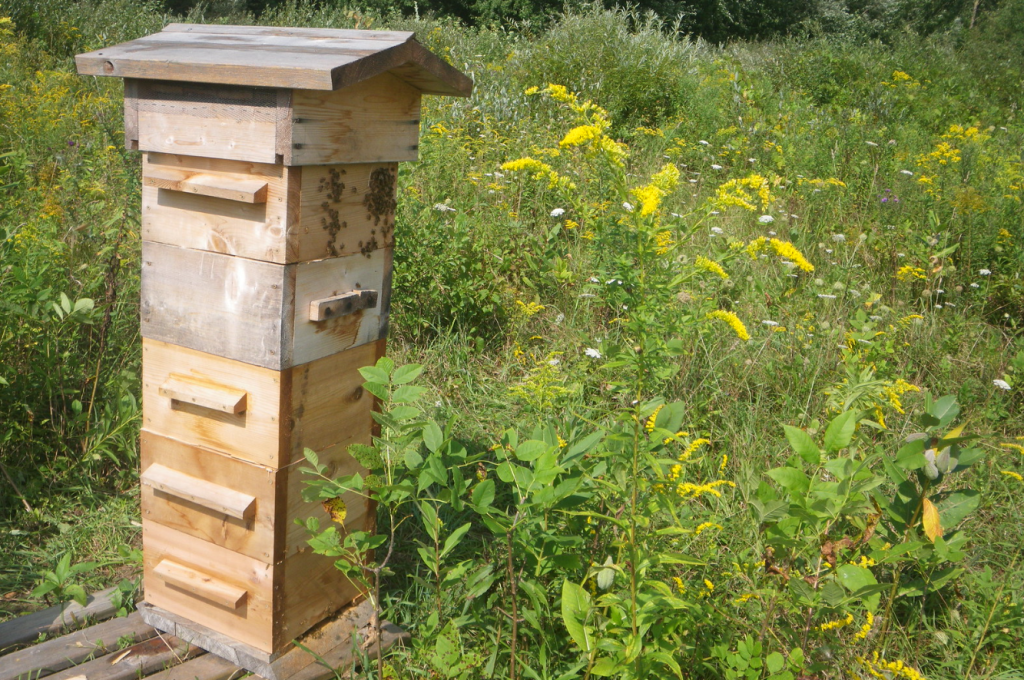
Beyond the hive itself, there are a few essential tools you’ll need. A beekeeping suit (to protect against those inevitable stings), a smoker (to calm the bees during inspections), and a hive tool (to lift frames and pry things apart) are all crucial investments for new beekeepers.
Location is also key when it comes to hive placement. Your bees need a spot with plenty of sunlight, protection from strong winds, and access to water. Additionally, consider the surrounding flora—plants and flowers that bees love will ensure they have abundant nectar and pollen sources.
Starting Your Colony: Sourcing and Installing Bees
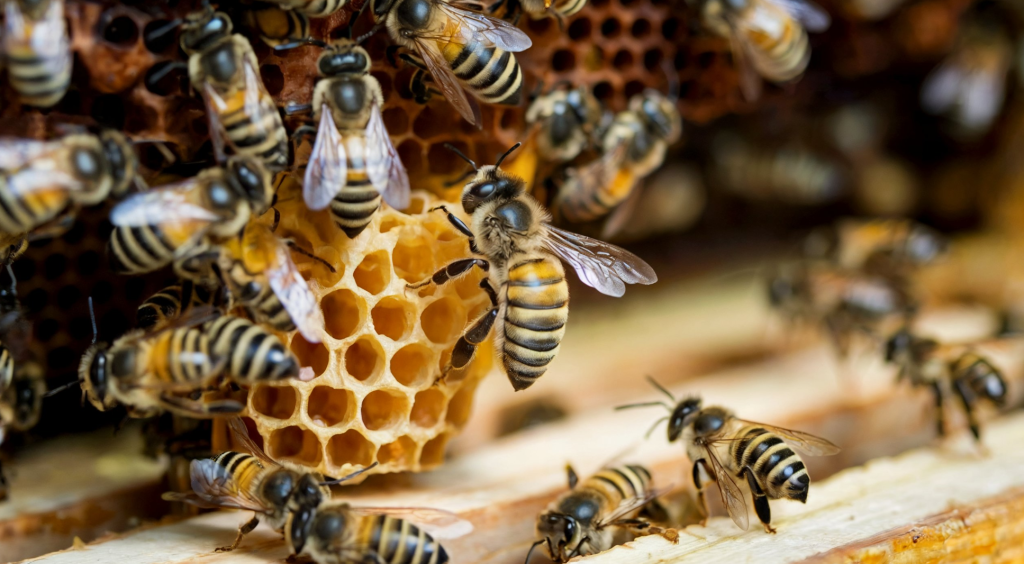
When you’re ready to introduce bees to your homestead, sourcing your colony becomes the next step. You have a few options: nucleus colonies (or nucs), packages of bees, or capturing a wild swarm.
Nucs are small, established colonies with a queen, workers, and brood already working together—an excellent choice for beginners.
Packaged bees are another option, typically sold by the pound with a separate queen in a cage, ready to be installed into your hive.
Installing bees into their new home is an exciting moment. Whether you’re working with a package or a nuc, the process involves gently introducing the bees into the hive and making sure the queen is accepted. Patience is key as the bees acclimate to their new surroundings.
In this video, Adam the Beekeeper on YouTube demonstrates the basics of introducing a queen to the hive, the most essential moment for the longevity of your beekeeping journey.
Once your bees are settled, it’s essential to create a welcoming environment. Ensure they have easy access to water, nearby forage, and plenty of space to build their comb.
You’ll be on your way to a thriving colony in no time!
Understanding Bee Behavior: Inside the World of the Hive
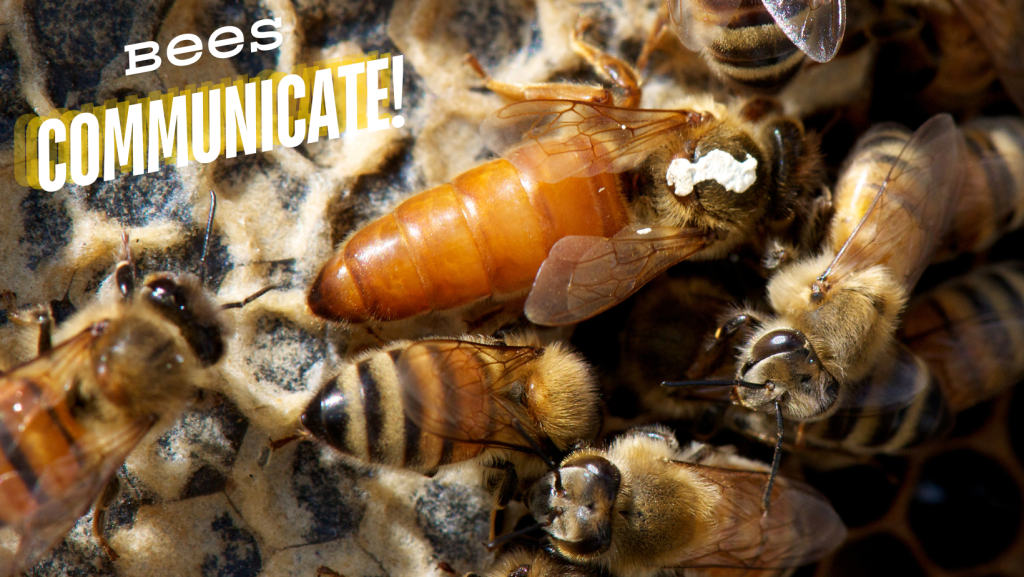
Understanding the life cycle of the honeybee is crucial for keeping a healthy hive. Workers live only a few weeks in summer, while the queen can live several years. Their brief yet critical lifespan means beekeepers must always be mindful of population fluctuations.
Bees operate like clockwork within their hive, each member of the colony knowing their role and carrying it out with precision. At the heart of this tiny empire is the queen. She’s the sole egg layer, and her pheromones maintain order within the colony. The worker bees—females who don’t reproduce—take on various tasks such as foraging, cleaning, feeding the young, and defending the hive. Lastly, drones (the male bees) have just one job: to mate with a queen.
Bee communication is another fascinating element of the hive. One of the most intriguing behaviors is the “waggle dance,” where bees convey the direction and distance of food sources to their fellow foragers. Pheromones also play a significant role in hive communication, signaling everything from the presence of a queen to a threat to the colony.
Beekeeping Through the Seasons: Managing Your Hive Year-Round
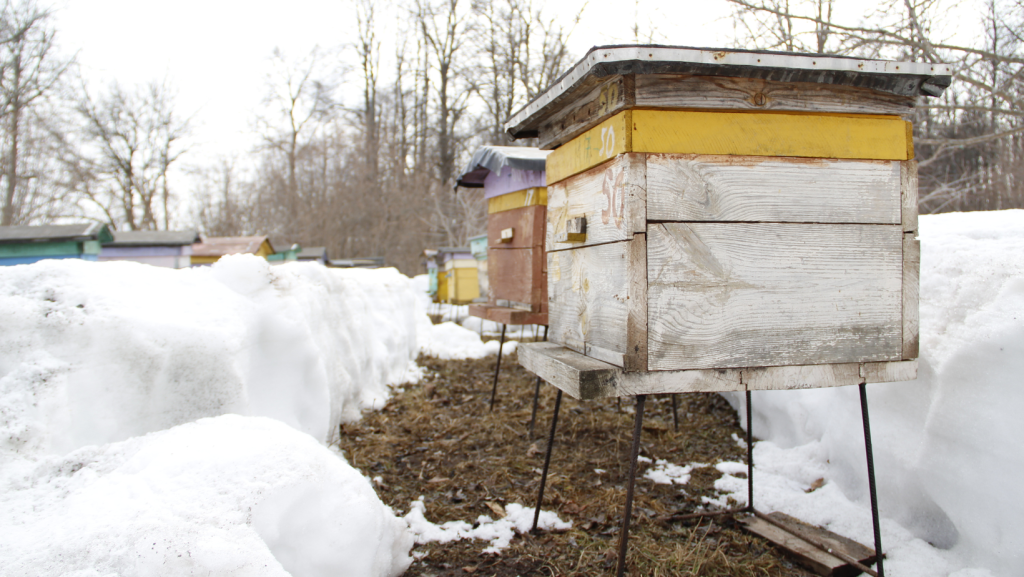
Beekeeping is a year-round endeavor, and each season brings unique responsibilities. Spring is the busiest time in the hive. It’s when the colony grows rapidly, and you need to prepare for the honey flow and potential swarming. Regular inspections will help you monitor the hive’s health and identify early signs of overcrowding or queenlessness.
In summer, it’s time to enjoy the fruits of your labor—literally. Honey extraction begins, and your role is to ensure your bees have ample space for honey storage while keeping pests at bay.
Fall signals a shift in priorities. As temperatures cool, your bees will need help preparing for winter. Feeding your colony sugar syrup and insulating the hive will keep them strong through the cold months.
And during winter, your primary role is to protect the hive from freezing winds and ensure they have enough stored food to last until spring.
Common Challenges: Troubleshooting Your Beehive
Even experienced beekeepers encounter challenges, so don’t be discouraged if things don’t always go smoothly. One of the most persistent issues is pests. Varroa mites, small hive beetles, and wax moths can wreak havoc on a colony if not controlled. Regular inspections and treatments, whether natural or chemical, are necessary to keep these pests at bay.
B&K Bees on YouTube offers a full series of beekeeping 101 courses, but by their own admission part 11 shown below is their most important. The challenges of beekeeping can be frustrating, particularly if they are completely unexpected. This video demystifies the various issues and will help you begin your beekeeping journey with confidence.
Diseases are another concern. Foulbrood, Nosema, and chalkbrood are just a few of the bacterial and fungal infections that can spread through a hive. Identifying the symptoms early and taking swift action can often save the colony.
Swarming, while a natural process, can also pose problems. If a hive becomes too crowded, the old queen and half the colony will leave to start a new hive elsewhere. Managing hive space and monitoring queen cells are crucial to preventing or controlling swarming behavior.
Harvesting Honey and Wax: A Rewarding Payoff
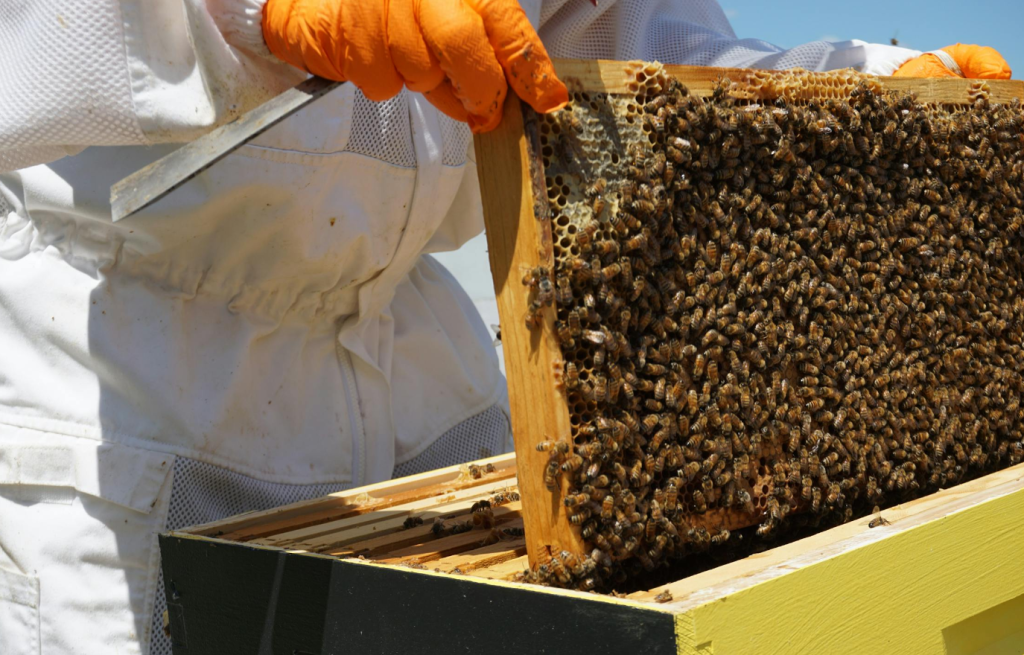
When the time comes to harvest honey, it’s not just about the sweet reward—it’s a sign that your bees are thriving. Knowing when to harvest is key; you want to ensure that the honey is fully capped and ready.
One common method for extracting honey is the crush-and-strain technique. This process involves breaking the honeycomb with an uncapping knife or multi-tool scraper and straining it through a fine mesh to separate the honey from the wax, as seen above. It’s a simple, low-cost method ideal for small-scale beekeepers, though it requires destroying the comb, which bees must rebuild.
A far more gentle method can be seen below by using a wooden spoon in place of a metal scraper. This can still lead to damage, and some beekeepers suggest waiting for a full cap to form before extraction. But this does look delicious!
For higher-volume extraction and processing, using a centrifugal extractor is most efficient and effective in separating honey from the comb. A centrifugal extractor will also extract honey from a beehive without damaging the comb.
By spinning the frames at high speed, the extractor uses centrifugal force to pull the honey out of the cells and collect it for processing. This method preserves the wax structure, allowing bees to reuse it for future honey production.
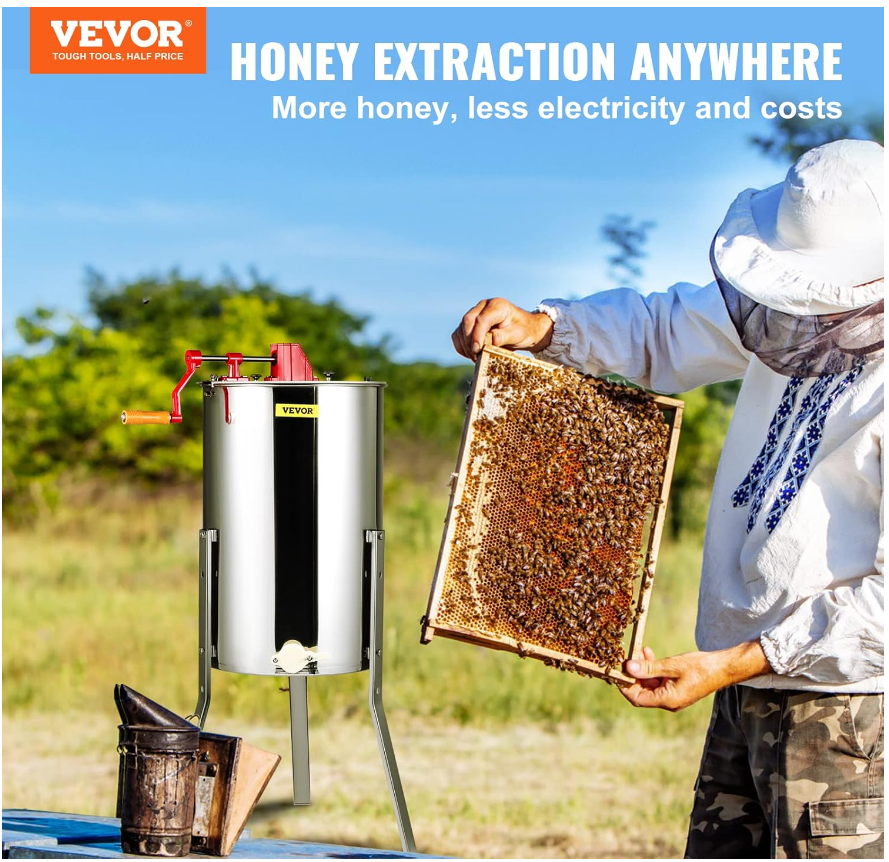
Protect your combs quickly and efficiently. This centrifugal extractor makes beekeeping much easier. Three-frame capacity, ergonomic handle and polished stainless steel!
Beeswax is another valuable product of beekeeping. After harvesting honey, the leftover wax can be used to make candles, balms, and various cosmetics. This versatility makes beekeeping even more rewarding, offering multiple ways to enjoy your hive’s bounty.
The Importance of Pollinators: How Your Bees Benefit the Homestead (and the planet)
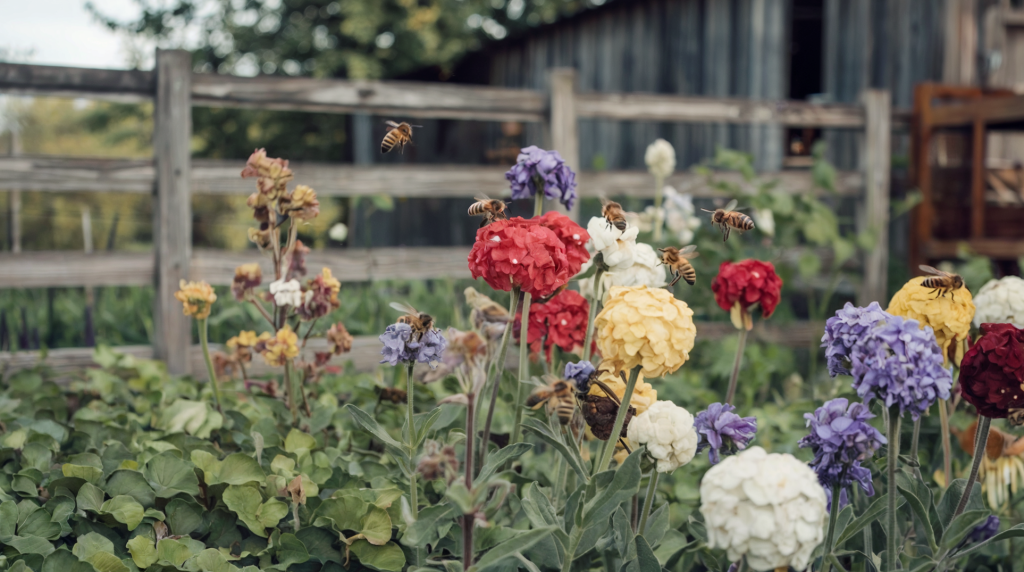
Bees are the unsung heroes of garden productivity. Their pollination services are vital to the health of fruit trees, vegetables, and flowers. Without them, many plants would struggle to produce the bounty we rely on. The simple presence of a hive can dramatically increase the yield of crops, making your homestead far more efficient.
To encourage a robust pollinator-friendly environment, plant diverse flowers, herbs, and trees. Bees are particularly drawn to plants such as lavender, sunflowers, and fruit blossoms. By filling your homestead with bee-friendly plants, you create a haven for them, which in turn strengthens the local ecosystem.
Building a healthy local community of pollinators also pays dividends far beyond the individual homestead. Without pollination from bees, many fruits, vegetables, and nuts would be scarce or non-existent. Supporting bee populations boosts biodiversity and ensures a stable food supply far and wide. The Food and Agriculture Organization of the U.N. has been highlighting the immense importance of bees for nearly a decade (my emphasis added):
“Without pollinators, many of us would no longer be able to enjoy coffee, chocolate and apples, among many other foods that are part of our daily lives,” said Simon Potts, Ph.D., the other assessment co-chair and Professor of Biodiversity and Ecosystem Services, School of Agriculture, Policy and Development, University of Reading, United Kingdom
More than three-quarters of the world’s food crops rely at least in part on pollination by insects and other animals.
Between US$235 billion and US$577 billion worth of annual global food production relies on direct contributions by pollinators.
Organic Beekeeping: Building a Hive for the Future (and profit!)
Practicing organic and chemical-free beekeeping is a growing movement among conscientious beekeepers. By avoiding synthetic treatments, you encourage the natural resilience of your bees and support a healthier environment.
In fact, over the last five years, interest in organic beekeeping has surged. The rise of urban beekeeping, facilitated by innovative hive designs like the Flow Hive shown below, has contributed to this trend, making it easier for beginners to start their own colonies.
Additionally, beekeeping has grown as a tool of empowerment in communities, especially in underdeveloped regions where apiculture helps improve livelihoods and food security. An increasing number of people are even creating backyard business ideas from their hives!
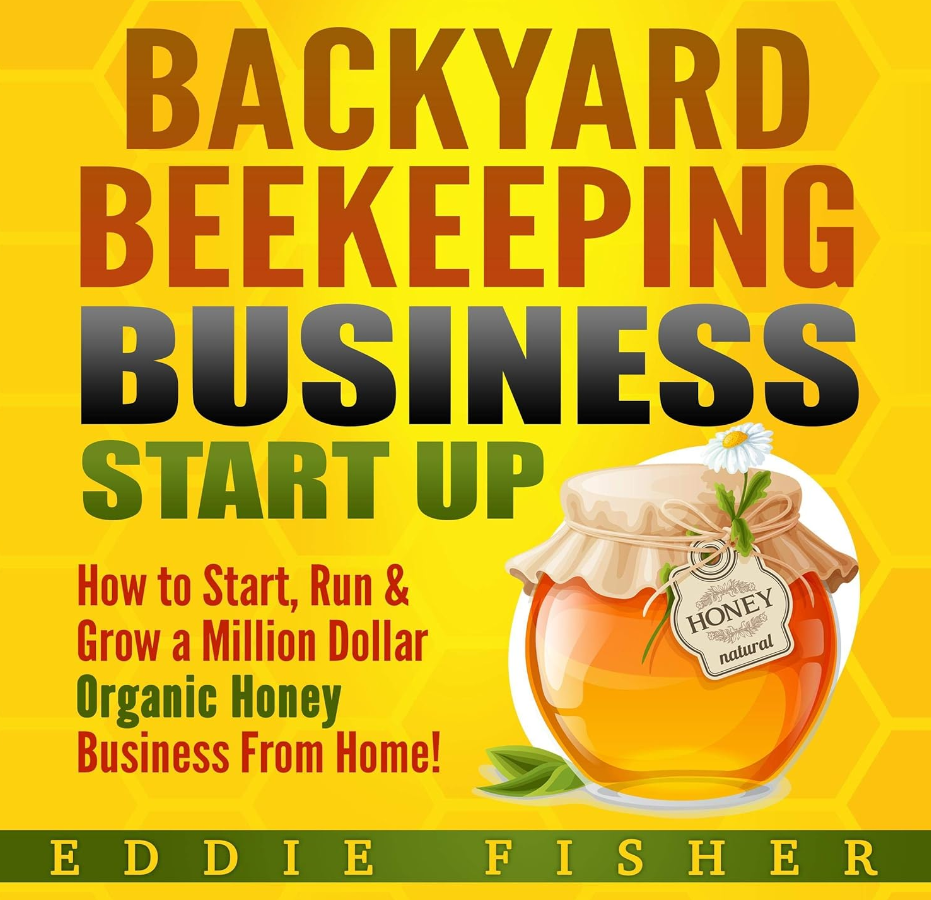
Why not turn your passion into profit? Backyard beekeeping is surging, and consumers are looking for organic natural honey to enhance their health and support the environment.
Splitting colonies and raising your own queens is another way to build a self-sustaining hive. This method reduces the need for outside bee sources and strengthens your colony’s genetic pool. In turn, you play a small but crucial role in supporting global bee populations, which face threats from habitat loss, pesticides, and climate disruption.
Embracing Beekeeping as a Homestead Essential
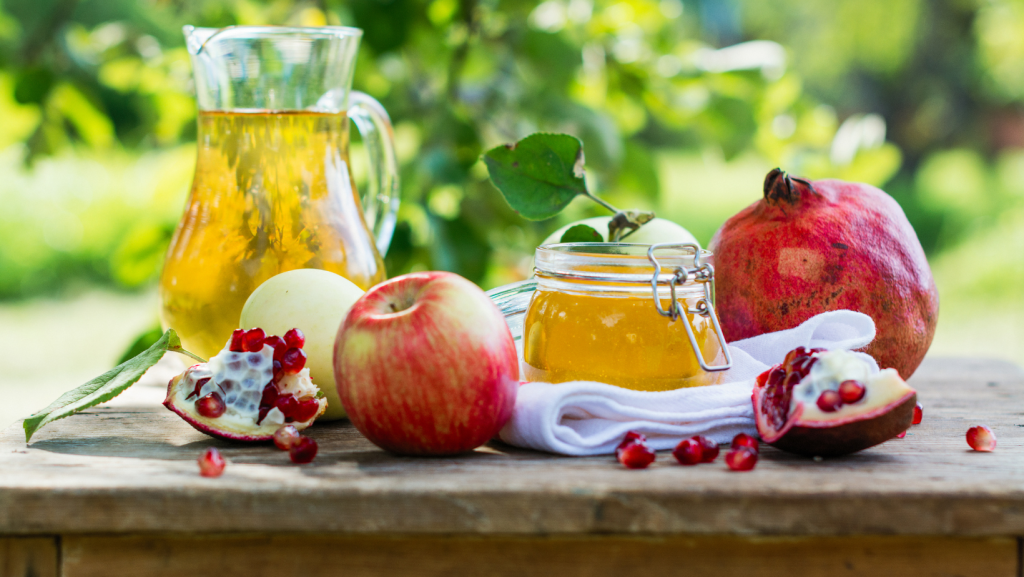
Beekeeping is more than a hobby—it’s a cornerstone of a self-sufficient, sustainable homestead. It connects you to nature in a profound way, teaches patience, and rewards your efforts with honey, wax, and a flourishing garden.
Whether you’re driven by sustainability, a love for honey, or simply a desire to contribute to the well-being of our ecosystems, there’s no better time to start your beekeeping journey. The rewards will be sweet, indeed.
See Our Latest Posts
- Simple Recipes for DIY Herbal Salves and Balms
- Delicious One-Pot Homestead Meals from Pantry Staples
- 5 Best Meat Dehydrators for DIY Jerky on Amazon (2025)
- Urban Homestead Hacks from Backyard to Balcony
- Creative Strategies for Frugal Homesteading
Write A Guest Post For Us!
Are you passionate about gardening, raising livestock or preserving food? We’re excited to announce that we’re now accepting guest posts for all aspects of homesteading!
